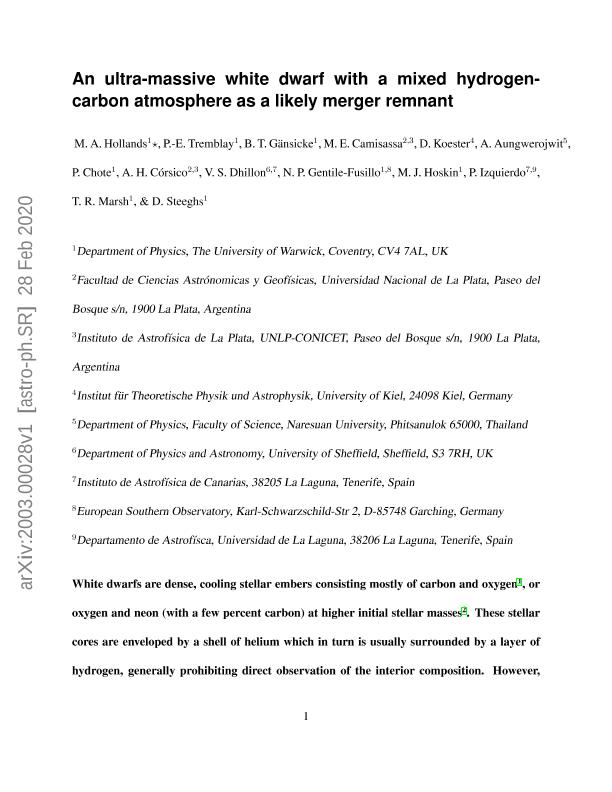Mostrar el registro sencillo del ítem
dc.contributor.author
Hollands, M. A.
dc.contributor.author
Tremblay, P. E.
dc.contributor.author
Gänsicke, B. T.
dc.contributor.author
Camisassa, María Eugenia

dc.contributor.author
Koester, D.
dc.contributor.author
Aungwerojwit, A.
dc.contributor.author
Chote, P.
dc.contributor.author
Corsico, Alejandro Hugo

dc.contributor.author
Dhillon, V. S.
dc.contributor.author
Gentile Fusillo, N. P.
dc.contributor.author
Hoskin, M. J.
dc.contributor.author
Izquierdo, P.
dc.contributor.author
Marsh, T. R.
dc.contributor.author
Steeghs, D.
dc.date.available
2021-11-02T17:09:54Z
dc.date.issued
2020-03
dc.identifier.citation
Hollands, M. A.; Tremblay, P. E.; Gänsicke, B. T.; Camisassa, María Eugenia; Koester, D.; et al.; An ultra-massive white dwarf with a mixed hydrogen–carbon atmosphere as a likely merger remnant; Nature Publishing Group; Nature Astronomy; 4; 3-2020; 663–669
dc.identifier.uri
http://hdl.handle.net/11336/145761
dc.description.abstract
White dwarfs are dense, cooling stellar embers consisting mostly of carbon and oxygen, or oxygen and neon (with a few per cent carbon) at higher initial stellar masses. These stellar cores are enveloped by a shell of helium, which in turn, is usually surrounded by a layer of hydrogen, generally prohibiting direct observation of the interior composition. However, carbon is observed at the surface of a sizeable fraction of white dwarfs, sometimes with traces of oxygen, and is thought to be dredged up from the core by a deep helium convection zone. In these objects, only traces of hydrogen are found, as large masses of hydrogen are predicted to inhibit hydrogen-helium convective mixing within the envelope. We report the identification of WD J055134.612+413531.09, an ultra-massive (1.14 solar masses (M☉)) white dwarf with a unique carbon-hydrogen mixed atmosphere (atomic ratio C/H = 0.15). Our analysis of the envelope and interior indicates that the total hydrogen and helium mass fractions must be several orders of magnitude lower than predictions of single-star evolution: less than 10-9.5 and 10-7.0, respectively. Due to the fast kinematics (129 ± 5 km s-1 relative to the local standard of rest), large mass and peculiar envelope composition, we argue that WD J0551+4135 is consistent with formation from the merger of two white dwarfs in a tight binary system.
dc.format
application/pdf
dc.language.iso
eng
dc.publisher
Nature Publishing Group

dc.rights
info:eu-repo/semantics/openAccess
dc.rights.uri
https://creativecommons.org/licenses/by-nc-sa/2.5/ar/
dc.subject
Astrophysics
dc.subject
Solar and Stellar Astrophysics
dc.subject.classification
Astronomía

dc.subject.classification
Ciencias Físicas

dc.subject.classification
CIENCIAS NATURALES Y EXACTAS

dc.title
An ultra-massive white dwarf with a mixed hydrogen–carbon atmosphere as a likely merger remnant
dc.type
info:eu-repo/semantics/article
dc.type
info:ar-repo/semantics/artículo
dc.type
info:eu-repo/semantics/publishedVersion
dc.date.updated
2021-08-17T15:54:38Z
dc.identifier.eissn
2397-3366
dc.journal.number
4
dc.journal.pagination
663–669
dc.journal.pais
Reino Unido

dc.description.fil
Fil: Hollands, M. A.. University of Warwick; Reino Unido
dc.description.fil
Fil: Tremblay, P. E.. University of Warwick; Reino Unido
dc.description.fil
Fil: Gänsicke, B. T.. University of Warwick; Reino Unido
dc.description.fil
Fil: Camisassa, María Eugenia. Universidad Nacional de La Plata. Facultad de Ciencias Astronómicas y Geofísicas; Argentina. Consejo Nacional de Investigaciones Científicas y Técnicas. Centro Científico Tecnológico Conicet - La Plata. Instituto de Astrofísica La Plata. Universidad Nacional de La Plata. Facultad de Ciencias Astronómicas y Geofísicas. Instituto de Astrofísica La Plata; Argentina
dc.description.fil
Fil: Koester, D.. Christian Albrechts Universitat Zu Kiel.; Alemania
dc.description.fil
Fil: Aungwerojwit, A.. Naresuan University; Tailandia
dc.description.fil
Fil: Chote, P.. University of Warwick; Reino Unido
dc.description.fil
Fil: Corsico, Alejandro Hugo. Universidad Nacional de La Plata. Facultad de Ciencias Astronómicas y Geofísicas; Argentina. Consejo Nacional de Investigaciones Científicas y Técnicas. Centro Científico Tecnológico Conicet - La Plata. Instituto de Astrofísica La Plata. Universidad Nacional de La Plata. Facultad de Ciencias Astronómicas y Geofísicas. Instituto de Astrofísica La Plata; Argentina
dc.description.fil
Fil: Dhillon, V. S.. University Of Sheffield; Reino Unido
dc.description.fil
Fil: Gentile Fusillo, N. P.. University of Warwick; Reino Unido
dc.description.fil
Fil: Hoskin, M. J.. University of Warwick; Reino Unido
dc.description.fil
Fil: Izquierdo, P.. Universidad de La Laguna; España
dc.description.fil
Fil: Marsh, T. R.. University of Warwick; Reino Unido
dc.description.fil
Fil: Steeghs, D.. University of Warwick; Reino Unido
dc.journal.title
Nature Astronomy
dc.relation.alternativeid
info:eu-repo/semantics/altIdentifier/url/http://www.nature.com/articles/s41550-020-1028-0
dc.relation.alternativeid
info:eu-repo/semantics/altIdentifier/doi/http://dx.doi.org/10.1038/s41550-020-1028-0
dc.relation.alternativeid
info:eu-repo/semantics/altIdentifier/url/https://arxiv.org/abs/2003.00028#:~:text=28%20Feb%202020%5D-,An%20ultra%2Dmassive%20white%20dwarf%20with%20a%20mixed%20hydrogen%2Dcarbon,as%20a%20likely%20merger%20remnant&text=White%20dwarfs%20are%20dense%2C%20cooling,at%20higher%20initial%20stellar%20masses.
Archivos asociados
